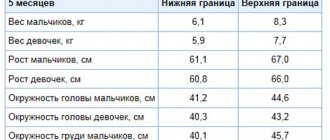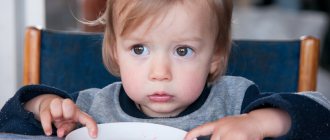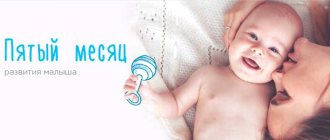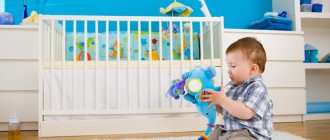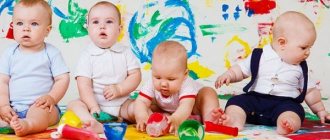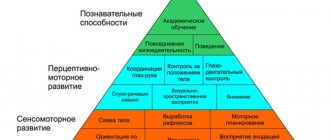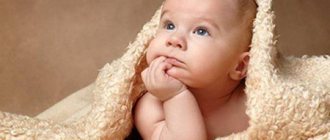Physical development at 12 months of life
During the twelfth month of life, the baby should gain 400 - 350 grams. By the age of one year, the child’s weight increases approximately 3 times.
The child’s body length increases by 1-1.5 cm during this month. Over 12 months of life, the baby’s body length increases by 1.5 times.
The circumference of the chest and head increases by 0.5 cm during the twelfth month of life.
On average, a 1-year-old baby’s height is 75 cm and weight is 10.5 kg.
By the end of the first year of life, a child should have 8 milk teeth.
The baby is 12 months old. Development and education of a one-year-old child
WHAT SHOULD A CHILD BE ABLE TO KNOW AT 1 YEAR OLD?
At the twelfth month, the baby gradually turns from a researcher into an experimenter.
He tries to perform various actions with objects in several ways.
He becomes so sociable that he not only enjoys meeting new people, but even tries to be naughty with them.
And while copying the actions of adults, he also repeats their manner of behavior and grimaces.
Physical development and motor activity of a one-year-old child
The baby moves around the house in all available ways. Can squat down and stand on tiptoes. Tries to take steps without holding onto support. At the same time, he often falls. He is interested in absolutely all subjects. He gets them out in any way, even pulling a string, a protruding part, a corner, so be attentive to what your baby is doing. From a standing position, he bends down to pick up a toy from the floor. Being carried away by the process of getting an overlying object, he can even climb to places where he is not able to get down on his own. And this circumstance can greatly frighten him.
The child performs previously learned actions with toys, transferring them to other toys. Can untie shoelaces independently. He flips through the pages of a book, but not always one at a time, and may even accidentally tear thin leaves. In the process of exploring objects and toys, the child tries to take them apart. Then he tries to return the object to its original state, but he cannot always connect all the components correctly. When a baby throws an object, he is already wondering where it will fall. Therefore, he begins to aim when throwing. When examining objects, he touches them. The same applies to food and dishes.
During bathing, the child behaves very actively, rolls over, waves his arms and legs, tries to get up and even get out of the bath.
Useful tips and recommendations for the mother of a one-year-old baby
1. Be sure to place a soft rubber mat in the baby bath.
2. Let your child “read” books on his own. If your child tears them up, give him unnecessary pieces of paper instead of books.
3. Give him toys that are easy to disassemble and assemble, as well as toys with laces for play.
Neuropsychic development and upbringing of a child at 12 months
A one-year-old child is interested in looking at photographs, pictures, drawings, small patterns with clear contours. He is even able to recognize a familiar person in a photograph.
Watches with curiosity how an adult writes or draws. The baby knows and can show parts of the body and repeats after the adult not only familiar simple words consisting of two identical syllables, but also new syllables. He develops his own “language”, in which he “chatters” with pleasure and a lot.
The baby already has a feeling of guilt, and he is able to withstand it. Now he strives to achieve the approval of an adult in response to his actions and deeds and enjoys being praised for something. However, he still plays mischief and teases. He prefers to play with adults or older children. He rather studies his peers. When playing with children, the baby expects their reaction to his actions and tries to take possession of exactly those objects that others are enthusiastically playing with. But he is also capable of exchanging toys with others.
At this stage, the child is already involved in the dressing process.
Useful tips and recommendations for the mother of a one-year-old baby
1. Place your baby’s toys in different boxes and baskets.
2. Tie colorful ribbons to the toys and wrap them in foil or bright paper.
3. Tie several toys into one garland.
4. Let your child look at albums with photographs of familiar people or himself.
5. Continue reading children's books to him.
RESULTS OF THE TWELFTH MONTH
Your baby will soon be one year old. Watching its development, you saw almost the entire evolution of humanity. From an absolutely helpless creature, the child turned into a fairly independent person. He learned to walk, talk and think. And although he still needs your help, he is already a person with his own view of the world around him.
Similar articles:
The baby is 1 month old. Baby development in the first month
Baby's sleep. How to ensure your baby sleeps soundly
How are keeping your baby warm and his good mood connected?
We care about the baby's health. Visit to the pediatrician. Vaccination calendar
The baby is 2 months old. What should it be like?
Neuropsychic development of a child at 12 months
A whole year of life is behind us, the baby is developing comprehensively. The development and improvement of motor skills and speech are actively underway. So what should a child be able to do at 12 months?
Motor development of a child at 12 months
By 12 months, many babies are already taking or trying to take their first steps. Some are already walking independently. They run quickly with the support of an adult.
The baby can stand independently and gets up from a squatting position.
The child can deftly climb onto low objects with the help of stands and can climb up and down steps.
Uses a cup, spoon, sippy cup.
Cognitive development of a child at 12 months
He observes with great interest the hygiene procedures of adults and imitates some of them.
If difficulties arise, the baby can call adults.
At the request of an adult, brings familiar toys or objects. Can grasp several toys with one hand at the same time. May place an object under the armpit to free the hand to grab something else.
At 12 months, a child knows how to use certain objects (putting a phone to his ear, knocking with a hammer, drinking from a cup, etc.).
He distinguishes primary colors well, can assemble a pyramid of 3-4 rings, and build a tower of 2-3 cubes.
Plays simple story games.
Recognizes and shows animals in pictures.
Child's emotional development
- The baby can fulfill simple requests from adults;
- Likes to imitate simple actions of adults;
- Dances to music;
- A sense of humor appears;
- Develops his own manner of behavior with adults;
- At one year old, the baby can distinguish between such concepts as “good” and “bad”, “possible” and “impossible”.
- Shows affection for loved ones and favorite toys;
- Begins to be capricious if he is dissatisfied with something.
Speech development 12 months
At one year old, the baby understands almost everything that is said to him.
By the end of the first year of life, the child’s vocabulary contains 8-15 words, the meaning of which he understands (dai, mom, dad, na, and others). There are also simplified and imitating words (am-am - eat, av-av - dog, tick-tock - clock and others). There are also those that only the child and mother understand.
Cognitive abilities
Babies of the first year of life are very curious, which, combined with the active development of intelligence and motor activity, gives amazing results.
The main sign of cognitive development is the observation and repetition of adult behavior. The baby already feels and understands the reaction of adults to various actions, movements, and sounds. He has well-developed facial expressions, he expresses his emotions well, sometimes doing this deliberately in order to evoke the appropriate reaction from others. He is very happy if he manages to make his parents laugh. Movements (dancing, bending, funny poses), facial expressions (antics, funny grimaces) are used.
At 12 months, a child already begins to show the beginnings of creative inclinations. It is worth observing the baby - what does he like? Some babies react very actively to music and immediately begin to move rhythmically. Others develop a passion for drawing. Finger paints are usually suitable for children at this age. Most children in the first year of life love movement, games of catch, and easy accessible physical activities.
One of the important stages of a child’s cognitive development at 12 months is the first signs of the self-preservation instinct. For example, this manifests itself in a fear of heights. Having climbed too high on the children's stairs, the child seeks support or the mother's hand. In some children, the instinct of self-preservation manifests itself in the form of fear of strangers, for example, doctors. It is very important at this stage to show the baby that he is safe, and also to set boundaries for available entertainment, but not to scare him.
A child of the first year of life gradually learns the properties of objects. During the game, he learns what hard and soft, hot and cold, dry and wet mean. A child at this age is very curious and actively explores the world around him. Animals are the most interesting and understandable to him. To help your baby develop, you can show him pictures of animals, simultaneously demonstrating what sounds they make. The main thing is to remember that any information should be presented in a playful way.
Factors in cognitive development include a child's social skills. Children at this age enjoy communicating with each other and actively contact adults. They love to play games (hide and seek, catch-up, round dances, creating simple structures from cubes). Of course, a child’s socialization depends on individual character traits, but in most cases, 1-year-old children love to play with their peers.
Caring for a baby at 12 months of age
A one-year-old child still needs daytime sleep, it should be at least 2.5 hours. The duration of night sleep is about 11 hours. It is better to accustom your child to a certain routine, preferably so that he falls asleep and wakes up at the same time.
Hardening procedures are no less important - air and sun baths, rubdowns, douches, walks in the fresh air, water procedures.
A year old, you can bathe your child every other day, the duration of bathing is from 10 to 20 minutes.
Nobody canceled daily hygiene measures either. Every morning, wash your baby, comb his hair, and brush his teeth. Keep your ears and nails clean.
Your baby's routine should include massage and gymnastics. Exercises and techniques become more complex according to the age of the child.
The feeding regimen at 12 months is the same - 5-4 times a day.
Particular attention should be paid to the oral cavity. Dentists recommend starting to brush your teeth from the moment they appear. To care for your first teeth, you can purchase a special toothbrush at the pharmacy.
Daily routine at 12 months
Sleeping mode
The baby still needs long sleep of 13-14 hours a day.
Some children at this age switch to one nap during the day. In this case, it must last at least 2 hours and end no later than 16:00. Then the period of wakefulness until the evening bedtime will be sufficient for the baby to get tired. And in the evening it will be easier to put him to bed. The duration of night sleep will be 11-12 hours. Walks
A mandatory part of the regime is a daily walk. Ideally, you should spend as much time as possible outdoors, especially in the warm season. Walking minimum 1.5-2 hours a day. It is advisable that the walk does not occur during the daytime sleep. At one year old, a child is actively exploring the world; you can walk with him not only in a stroller, but also on the playground, and involve him in communicating with other children.
Nutrition
It still remains five times. There will be no fundamental differences from 11 months. If you continue breastfeeding, leave 2 applications per day - morning and evening. When artificial feeding, these feedings are replaced with a mixture that meets age-related needs.
A child's daily diet should contain 1200-1300 calories:
- Fermented milk products (kefir, yogurt) 200 ml per day;
- Cottage cheese (fresh, casserole, cheesecakes) 70g per day;
- Quail or chicken eggs (in the absence of allergies) no more than 3 times a week, 1 piece;
- Vegetables and fruits 200g per day. Over the course of a year, you can gradually introduce new fruits, berries, and vegetables;
- Meat products (turkey, chicken, veal) 200g per day. You can make meatballs, soufflés, and meatballs from the meat.
- Low-fat fish (cod, pike perch) 2 times a week, 40 g;
- Porridges and cereals (corn, rice, buckwheat, oatmeal, multigrain);
- Drinks (juices, dried fruit compotes);
At one year of age, all children actively learn to chew food. Therefore, the child’s table must be organized in such a way that it includes both ground-up dishes and dishes with soft pieces.
Useful habits
At 1 year old, you can safely teach your baby good habits: washing and brushing his teeth in the mornings and evenings, washing his hands before eating and after returning from a walk, and putting him on the potty. It is also recommended to bathe your baby daily. Water treatments have a beneficial effect on development and help strengthen the immune system. For comfortable swimming, the water temperature should not be higher than 37-38 degrees.
Nutrition for a 1 year old child
By the end of the first year of life, you can gradually begin to introduce solid foods into your child's diet. So, you can give a one-year-old baby a piece of apple, a cookie, or a cracker.
Please note that if you give your baby solid food, do not leave it unattended, as the baby may bite off too much and choke.
A child’s diet at 12 months is already very varied; its menu includes basic foods (vegetables, fruits, meat, fish, butter, dairy products, bread and others).
Dairy products are very important in a child's diet. By the end of the first year of life, it is recommended that the baby drinks about 400-500 ml of milk, kefir or yogurt. Milk can be used to prepare porridges and soak cookies in it. Also, the child’s diet should include cottage cheese.
It is better to give meat products to the baby in the first half of the day, so that the digestive system has time to cope with it before going to bed and there are no problems with the tummy.
Once or twice a week, it is recommended to replace meat dishes with fish. For a one-year-old baby, sea fish and non-fatty fish are best suited.
The porridges are very filling and healthy.
To make your baby eat porridge more willingly, you can add vegetables or fruits to it according to your baby’s taste.
Fruits and vegetables are sources of vitamins, minerals and fiber. They must be present in the diet of a one-year-old baby.
It is very useful to give your baby compotes, jelly, and freshly squeezed juices.
Despite the fact that breastfeeding experts recommend breastfeeding your baby until he or she refuses breastfeeding, many mothers begin weaning their baby after a year. Of course, at this age, breastfeeding is more a psychological act than a nutritional element, so you should wean your baby off the breast gradually so as not to injure him.
Thus, by the age of one year, the child has developed a diet consisting of breakfast, lunch and dinner, as well as breast milk or an adapted milk formula.
Necessary examinations of a child at 1 year
A routine examination by a pediatrician is required every year to assess the child’s physical and neuropsychic development.
It is also necessary to visit a number of specialized specialists: a neurologist, a surgeon, an ophthalmologist, an orthopedist, an otorhinolaryngologist (ENT doctor), and a dentist.
Take a series of tests: a general blood test, a general urine test, a general stool test (scatology), a stool test for worm eggs.
According to the national calendar of preventive vaccinations, people are vaccinated against measles, mumps and rubella every year.
Children are also given the Mantoux test (to detect tuberculosis).
